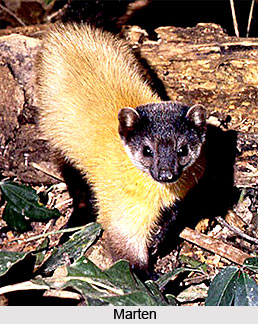 The Marten, a small to medium-sized carnivorous mammal, is
part of the Mustelidae family. These agile creatures are known for their sleek
bodies, bushy tails, and sharp claws. In India, martens are represented by two
species: the Nilgiri marten (Martes gwatkinsii) and the Yellow-throated marten
(Martes flavigula).
The Marten, a small to medium-sized carnivorous mammal, is
part of the Mustelidae family. These agile creatures are known for their sleek
bodies, bushy tails, and sharp claws. In India, martens are represented by two
species: the Nilgiri marten (Martes gwatkinsii) and the Yellow-throated marten
(Martes flavigula). Physical Features
Martens possess distinct physical characteristics that
facilitate their survival in the wild. They have elongated bodies with short
limbs, aiding in their agility and ability to navigate through dense forests.
Their fur is typically thick and lustrous, providing insulation against cold
weather. The Nilgiri marten exhibits a dark brown to black coat with an orange
throat patch, while the Yellow-throated marten is noted for its striking yellow
and brown coloration, with a bright yellow throat and chest. Adult martens
generally weigh between 1 to 2 kilograms and measure about 50 to 70 centimeters
in length, including their bushy tails which account for nearly one-third of
their body length.
Martens thrive in forested environments where they can find ample food and cover. In India, they inhabit both tropical and temperate forests, ranging from lowland rainforests to montane regions. The Nilgiri marten is predominantly found in the Western Ghats, preferring the higher altitude shola forests and grasslands. These areas provide a mix of dense undergrowth and open spaces, ideal for their hunting and nesting activities. The Yellow-throated marten, on the other hand, has a broader range, occupying various forest types across the Himalayas and the northeastern states. These martens are highly adaptable, capable of surviving in primary forests as well as secondary growth and disturbed habitats.
Concentration in India
The distribution of martens in India is largely determined by the availability of suitable habitat and prey. The Nilgiri marten's range is relatively restricted to the Western Ghats, specifically in the states of Tamil Nadu, Kerala, and Karnataka. This species is considered endemic to this region and is rarely found outside these geographical confines. Key locations include the Nilgiri Hills, the Anamalai Hills, and the Palani Hills. Conservation areas such as the Silent Valley National Park and the Periyar Wildlife Sanctuary are critical habitats for the Nilgiri marten.
In contrast, the Yellow-throated marten exhibits a wider
geographical spread. It is found throughout the Himalayan region, extending
from Jammu and Kashmir in the west to Arunachal Pradesh in the east.
Additionally, it inhabits the forests of northeastern India, including Assam,
Meghalaya, Nagaland, and Manipur. This species is also present in the hill
ranges of central India and occasionally reported in the Western Ghats,
although less commonly than the Nilgiri marten.
Conservation Status
The conservation status of martens in India varies between the two species. The Nilgiri marten is classified as "Vulnerable" on the IUCN Red List due to its limited range and the ongoing threat of habitat destruction. Deforestation, human encroachment, and fragmentation of forest habitats pose significant risks to their populations. Conversely, the Yellow-throated marten is listed as "Least Concern," reflecting its wider distribution and greater adaptability to changing environments. However, this species also faces threats from habitat loss and hunting.
Martens in India represent a vital component of the
country's diverse wildlife.
Their unique physical features, specialized habitats, and varying conservation
statuses underscore the need for targeted conservation efforts. Protecting the
forested regions of the Western Ghats and the Himalayan ranges is crucial to
ensuring the survival of these fascinating mammals. Through sustained
conservation initiatives and habitat preservation, India can continue to
support healthy marten populations.